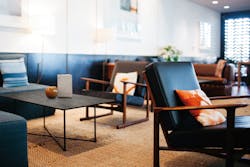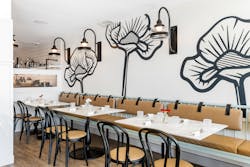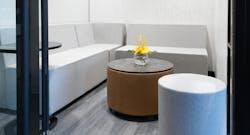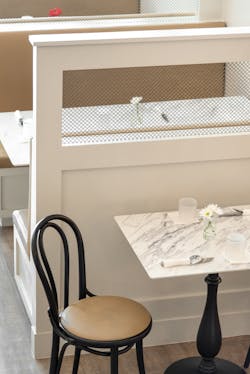New Composite Slab Surfaces Shine in the Commercial Product Spotlight
Whether you are specifying for reception desktops, restroom vanities, kitchen and breakroom countertops, or restaurant table and bar tops, there are plenty of options available in commercial surface materials. But in the perpetual effort to balance the demands of performance, aesthetics and budget that each new project requires, choosing among such perennial players as HPL/laminate, solid surface, quartz and granite or natural stone is anything but simple. Each material has its own combination of pros and cons that must be weighed in the decision-making process.
However, a new option in commercial surface materials offers a combination of high-end design, durable performance, ease of maintenance and budget-friendly total installed cost unmatched in the industry: composite slab. This extraordinarily strong, high-performing structural material is engineered by compressing a combination of papers and resins under high heat and pressure. Composite slab has been a popular residential worktop surface in Europe for years, and it’s a natural fit for the American commercial market, which is always in search of durable, affordable materials with a modern aesthetic.
High-end Designs Inspired by Nature
Patrick Allen, senior interior designer with Unhinged Studio in Austin, TX ,recently specified composite slab for the tables at Goodfolks restaurant. He and studio principal Joy Flores were seeking a bright, clean marble look to balance darker tones and patinated surfaces in the historical space.
“The marble look was just so warm and had such depth,” Allen explained. “It is all over the restaurant’s Instagram because it’s a perfect backdrop to show off food.”
The natural beauty and realism of composite slab designs are comparable to those of other engineered surfaces–including ones at significantly higher price points.
High-impact Performance with Low Maintenance
Composite slab surfaces offer the highest level of impact resistance among commercial surfaces as well as excellent resistance to heat, scratches, cuts and water, making it an all-around superior option for high-use applications such as restaurant tabletops, reception desks, restroom vanities and office kitchen or breakroom countertops.
Ted Liebig of Trend Manufacturing Company in Chesterfield, MO, who has fabricated composite slab surfaces for such diverse projects as high-rise apartments, a country club and a cooking school, performs what he calls “the dumpster test” to demonstrate its strength to general contractors and developers. “If I take a piece of quartz outside and drop it over the edge of a dumpster, it breaks. Composite is so impact resistant–I can slam it against a dumpster all day long and it’s not going to break.”
Beyond the design, durability and impact resistance were key reasons Unhinged Studio chose composite slab. “It was just a natural choice that came with real practical performance for a restaurant,” Allen said. “It is relatively lighter in comparison to other surfaces, and staff members don’t want to move a heavy quartz or stone table around and risk tipping and chipping or breaking the edges.”
In addition to the potential to crack and chip, granite and other natural stone surfaces are porous and must be sealed periodically to prevent absorbing stains and odors. Depending on the surface texture or finish, care must also be taken in the choice of cleaning products, as strong acids or bases may pit or scar the surface.
However, composite slab is a non-porous material that is stain resistant and requires no sealing. While it is easy to clean with mild detergents, it also stands up to heavy commercial cleaning and disinfection protocols.
Domestically Manufactured for Sustainability and Availability
As natural materials that aren’t considered scarce, granite and stone may seem like an ecofriendly choice. However, quarrying and transport of heavy slabs requires a great deal of energy. In particular, the inexpensive granite tops being specified for hospitality and multifamily projects are shipped from Asia.
Composite slab surfaces achieve superior durability and performance in a thinner profile, thus using less material and eventually creating less waste. In addition, the combination of lighter weight and domestic production minimizes their carbon footprint for transportation. Look for products that offer EPDs, HPDs and FSC certification to establish material and supply chain transparency as well as those that are GREENGUARD Gold certified for low emissions.
Domestic manufacturing not only makes composite slab a more sustainable choice—it also dramatically cuts down lead times and makes it more available. One of Trend Manufacturing’s first experiences with composite slab occurred when the developer on a project had specified another material out of Italy that had a 16-week lead time. Liebig was able to convince him to replace it with a domestically made composite slab product that was available in a fraction of the time.
Lower Total Installed Cost
There are standard steps that all commercial surface materials require in the transformation from raw product to installation-ready surface. Some materials require more steps, and some require more sophisticated machinery and labor to complete these steps, which adds to the total cost of the finished product.
Choosing composite slab surfaces simplifies the essential steps and eliminates extra ones. As a complete slab, it does not need to be applied to a panel or substrate. The edges only require profiling and sanding–no adding edge strips or building down the edges. All fabrication can be done with dry CNCs or standard woodworking tools common to any fabrication shop. In fact, fabricators can complete up to three times the number of composite slab tops as other surfaces in the same amount of time.
Transportation and handling efficiencies also keep the total installed cost of composite slab surfaces down. For a standard 1 ¼-in. thick surface, granite and quartz weigh in at roughly 18-20 lb. per square foot. Solid surface is considerably lighter at 5 lb. per square foot. HPL over an MDF core is around 4.5 lb. per square foot. Because composite slab combines durability with a streamlined profile, it weighs in at 3.6 lb. per square foot, making it less expensive to transport and easier to handle and install with less manpower.
The structural integrity and impact resistance of composite slab material increases overall yield by virtually eliminating breakage during fabrication, transportation and installation. This allows for more precise material ordering, without as much overage to account for waste or breakage.
In terms of overall costs, the material itself is as much as 30% less than options with comparable high-end designs. With fewer steps and fewer hours of labor than other commercial surface materials, fabrication is up to three times faster. And due to its light weight and strength, composite slab can be stacked flat on pallets, carried easily and installed twice as fast as other materials.
The Bottom Line
Every material has its own unique combination of benefits and drawbacks, but for applications that require a balance of high-end nature-inspired design, a sleek modern profile, incredible impact resistance and durability, U.S.-manufactured sustainability, all at a remarkably efficient total installed cost, new composite slab is an exciting alternative to traditional commercial surface materials.
For more information on composite slab, visit wilsonart.com/thinscape.
About the Author
Ricky Crow
Ricky Crow has served as Vice President of Product Management (HPL) for Wilsonart Engineered Surfaces since February 2020. Ricky is responsible for overseeing the laminate product line across the global enterprise. He joined Wilsonart in 1998 as a Chemist and has progressed through various roles of increasing responsibility, most recently as Director of High Pressure Laminate for the Americas. Ricky holds a bachelor’s degree in Chemistry from Texas A&M University and an MBA from the Jack Welch Management Institute




